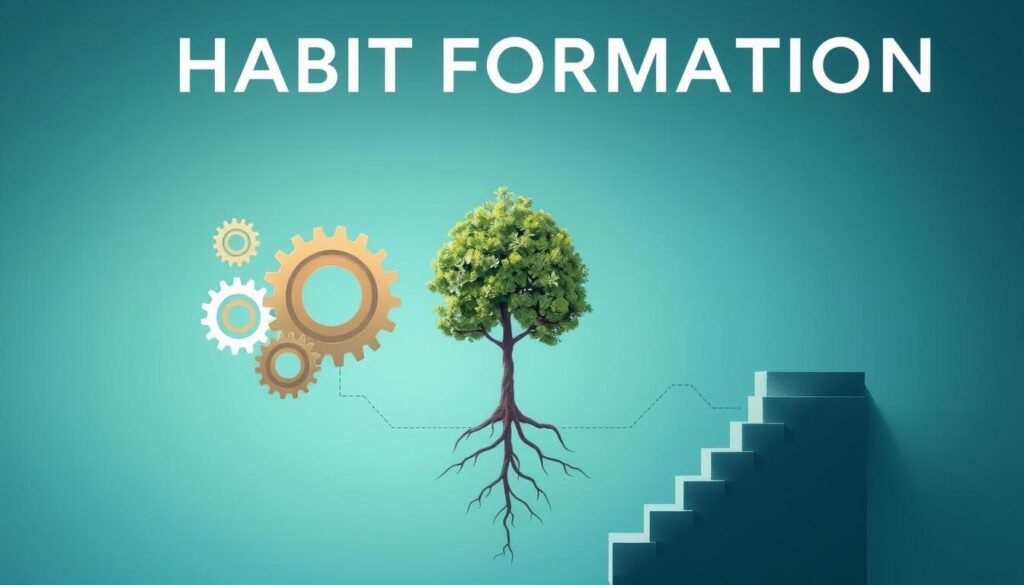“Atomic Habits” by James Clear is a top book that shows how tiny changes every day can lead to big results over time. It talks about the power of small habits getting 1% better each day. These small changes can greatly improve your life and success.
This book has been in Time magazine and the Wall Street Journal. It has sold over 20 million copies all around the world. Also, it’s been translated into more than 60 languages. The book shares useful advice like the Four Laws of Behavior Change. It is perfect for those who want to get better at creating good habits and being more productive.
Introduction to Atomic Habits
James Clear’s “Atomic Habits” came out on October 16th, thanks to Penguin Random House. It talks about how small, regular changes can really make a big difference. By understanding the core concepts of making habits, readers learn how to change behaviors. This knowledge comes from the study of biology, psychology, and how our brains work.

Clear believes that tiny steps lead to big rewards over time. He says it’s better to make little changes than big, scary ones. “Atomic Habits” teaches us that building up our identity is key to making habits stick.
Big names like Mark Manson, Adam Grant, and Ryan Holiday say this book really works. Clear gives step-by-step guides for making good habits. These include “Make It Obvious,” “Make It Attractive,” “Make It Easy,” and “Make It Satisfying.”
Getting to know “Atomic Habits” helps people create spaces where good habits can grow. For example, having books around makes it easier to pick up reading. The book compares Clear’s ideas to other models, helping readers make changes that last.
Claim Your FREE Copy of “Atomic Habits” Here.
The Four Laws of Behavior Change
James Clear’s “Atomic Habits” introduces the Four Laws of Behavior Change. This practical framework helps us start new habits and stop old ones. The process has four phases: cue, craving, response, and reward. Each one is key in making or breaking habits.

The first law, Make It Obvious, talks about the power of clear cues. About 40% of what we do daily is based on habits. This shows how big a role cues play in our actions.
The second law, Make It Attractive, is about making habits appealing. Studies show that dopamine helps us go after rewards. This makes us more likely to pick up the habit.
The third law, Make It Easy, is all about making habits simple to do. The Two-Minute Rule helps us start by doing something quick. Planning when and where to do a habit increases its chances by 300%.
The fourth law, Make It Satisfying, focuses on rewards. Rewards teach our brain what’s good to repeat. Tracking habits can increase their stickiness by 50%. This shows how making progress visible is important.
James Clear shows that the right cues, appeal, simplicity, and rewards help with habits. Habits go through specific steps. Things like social support also matter a lot in sticking to habits.
Atomic Habits
James Clear’s book, Atomic Habits, compares habits to compound interest. He says small changes grow big over time. This idea helps in many areas like business and learning.
Changing how we see ourselves is key to changing habits. A habit won’t last if it doesn’t fit our self-view. Clear’s Two-Minute Rule makes starting new habits easy by breaking them into small steps. This helps us do more with less effort.
Clear believes making the right environment is important for habits. A good environment helps us see good cues and ignore bad ones. This makes it easier to stick to good habits without needing a lot of willpower.
“You do not rise to the level of your goals. You fall to the level of your systems.” – James Clear
Clear likes using habit trackers to keep people motivated. Seeing your progress helps keep the energy up. He talks about making habits clear, fun, simple, and rewarding. This is his way of making good habits stick.
How to Build Good Habits and Break Bad Ones
To build good habits and break bad ones, know the cue, craving, response, and reward. James Clear says managing this loop is key for growth. It helps us change better and faster.
Researchers at Duke University found habits drive 40% of our daily actions. To change, start with small steps. These don’t need much motivation to begin.
Breaking big goals into smaller tasks keeps you going. Your first steps should give you a happy reward. This makes the cue stronger.
Habit stacking makes new habits stick. It ties them to ones you already have. This way, small changes fit into your day without much effort.
Digital devices can break your habit loop. They are like mental candy. Try to make spaces that help good cravings grow instead. Small daily upgrades lead to big gains.
Skipping a habit once doesn’t ruin your progress. What matters is bouncing back quickly. This shows setbacks aren’t the end. They’re just bumps in the road.
Lasting change comes when habits match your identity. It shows who you are. This makes new habits stick and old ones fade. It’s all about making small tweaks.
Claim Your FREE Copy of “Atomic Habits” Here.
Case Studies and Real-Life Examples
James Clear’s “Atomic Habits” includes many real-life success stories. These stories show us how tiny changes can lead to big improvements. They make it easy to see how we can change too.
“If you can get 1 percent better each day for one year, you will end up thirty-seven times better by the time you are done.”
The book shares 30 short stories from readers. These stories give us tips on forming good habits. For example, Roland ate better and Robert stopped smoking by focusing on new habits.
One reader gave themselves $10 for staying sober. It mixed a new habit with a reward. Then, Lisa read more books to develop a reading habit. She changed her surroundings to encourage her.
Heather drank more water by using colorful bottles. Max quit e-cigarettes and coffee at the same time. This helped him stay away from things that were bad for him.
People also used habit stacking, as explained in “Atomic Habits“. One person learned Mandarin by talking to taxi drivers. David meditated right after brushing his teeth.
Some readers changed their environments to eat less junk food. Cyd did this by making it harder to snack. Matthew and Viet redesigned their spaces to use less social media.
Replacing bad habits with good ones was another trick. Shawn and Suraj swapped smoking for eating candy and exercising. Another person used a weight bench instead of smoking. This helped reduce their craving.
These habit change examples show how James Clear’s advice works. Using real-life success stories helps motivate us. It also gives clear steps to make positive changes in our own lives.
Conclusion
“Atomic Habits” shares a strong message on how small, steady changes can really help us grow. James Clear teaches us about four key steps: cue, craving, response, and reward. These steps show us how tiny shifts can eventually lead to big wins.
Clear says that long-term changes come from our daily habits. He tells us that getting quick rewards makes us more likely to keep going. He also talks about how making something more fun can make it a habit.
The book explains why it’s important to focus on how we do things, not just on what we want to achieve. Setting up a habit system is better than just hoping for the best. “Atomic Habits” tells us that success is about making good habits obvious, fun, simple, and rewarding. Following these ideas can help us get better bit by bit.

